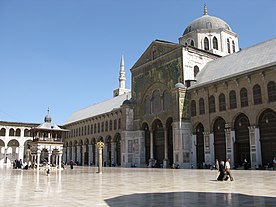Culture of the Umayyad Caliphate

As the first established caliphate, following the Islamic Conquest beginning in 622 AD, the Umayyads captured and occupied the former Byzantine and Sasanian Empires, from Mesopotamia to the Iberian Peninsula until 750 AD. This initial period was catalysed after the death of Muhammad, and marked the formative years of Islamic art.
Visual culture of umayyad
[edit]The conversation between Islamic art and other monotheistic religions, such as Judaism and Christianity, that co-existed alongside Muslim rule during the Middle Ages, can be depicted through decorative compositions. These can range from the display of geometric arrangements, to figural imagery in specific contexts. For example,
classical forms and media that had fallen into abeyance in preceding centuries…orthogonal planning, large-scale stone sculptures, and even the adoption of the external form of the Roman fort…as the basic model for the Umayyad qasr.[1]
This made Islamic art distinctive, and the longevity of these forms of architecture was significantly better than ones of a portable nature. For example, permanent artistic features within palatial residences included mosaics and friezes of intricate iconography. 'Senmurvs'[2] were an example of carvings - metamorphic forms that emerged during the Sasanian period (between the third and seventh centuries); produced and inspired by mythology, such as griffins.
Graeco-Roman influences were also littered among Umayyad stucco scenes, such as fruit-bearing vine scrolls and floral depictions that would have symbolised ‘supernatural fertility of paradise’.[3] Furthermore, acanthus-like scrolls of greenery can also be seen in the sculpture of the ancient Roman Ara Pacis, that inspired Islamic motifs and stylistic constructions.[4]
Similarly, these designs also featured on the Dome of The Rock, Jerusalem, that was also erected in the early eighth century. This site also reflects the importance of Syria and its Abrahamic associations to the Umayyad caliphate based in Damascus. It could be considered a patronage of monumental architecture, containing such ornate materials that continue a tradition of the Late Antiquity, but reconfigured in interesting and innovative ways.[1]

Similarly, the mihrab and the dome above the Great Mosque of Cordoba was decorated in blue, green and gold mosaics, that posed somewhat of a rival to the Great Mosque in western culture.[5]
Alternatively, supplemented by formal modes of development by the Byzantines and Sassanians, metalwork, textiles, depiction of animal, vegetal and figural motifs were influenced by Late Antiquity and naturalistic tradition, which had been prevalent from the eastern Mediterranean.
Despite this, coinage is the best evidence to depict a visual identity of the Umayyads of Syria,[1] with bronze examples being found in Qasr al-Mushatta after their minting had begun in 719-20 AD, Palestine.[6]
Significance of art
[edit]Arguably, as one of the driving forces in establishing the Umayyad rule, compositions in this period of the Late Antiquity 'were the earliest expressions of Islamic art on a grand scale’.[3] Not only did the first caliphal rulers establish a distinctive, stylistic trend that identified their emerging culture to support the spread of Islam, but further used this to form a web of alliances with alternative kingdoms that once occupied the fringes of the Mediterranean.
From Umayyad art, it is visible to see the adoption and development of techniques and styles in the later Abbasid art period. For example, the 'Samarian Dancers' wall painting.
Umayyad art can be attributed with starting the confluence of ‘east’ and ‘west’ art which continued throughout caliphal devoplment.[7] This viewpoint is consistently popular as they did not appear to conform to a fixed artistic binary, thereby applying a more 'holistic' approach to the study of significant Umayyad architecture.[8]
References
[edit]- ^ a b c Flood, Finbarr Barry; Necipoğlu, Gülru, eds. (2017-06-20). A Companion to Islamic Art and Architecture. doi:10.1002/9781119069218. ISBN 9781119068662.
- ^ Meinecke, Katharina (2014-04-30), "THE ENCYCLOPAEDIC ILLUSTRATION OF A NEW EMPIRE", Using Images in Late Antiquity, Oxbow Books, pp. 283–300, doi:10.2307/j.ctvh1dwzx.19, retrieved 2022-03-21
- ^ a b George, Alain; Marsham, Andrew, eds. (2017-12-21). "Power, Patronage, and Memory in Early Islam". Oxford Scholarship Online. doi:10.1093/oso/9780190498931.001.0001. ISBN 978-0-19-049893-1.
- ^ Luber, Diana Winfield (2020). A prolegomena to a new study of ornament : architecture as embodied ornament in the Great Mosque of Córdoba. University of Texas at Austin. OCLC 1224946640.
- ^ "Architecture and Ornament", The Islamic Villa in Early Medieval Iberia, Routledge, pp. 47–104, 2017-07-05, doi:10.4324/9781315086187-3, ISBN 9781315086187, retrieved 2022-03-28
- ^ Bisheh, Ghazi (1993). "From Castellum to Palatium: Umayyad Mosaic Pavements from Qasr al-Hallabat in Jordan". Muqarnas. 10: 49–56. doi:10.2307/1523171. ISSN 0732-2992. JSTOR 1523171.
- ^ The Metropolitan museum of art. The Gilliss press. 1920. doi:10.5479/sil.123365.39088002644706.
- ^ Hoffman, Eva R. (2008-01-01). "Between East and West: The Wall Paintings of Samarra and the Construction of Abbasid Princely Culture". Muqarnas Online. 25 (1): 107–132. doi:10.1163/22118993-90000127. ISSN 0732-2992.
